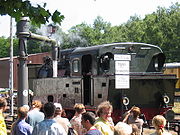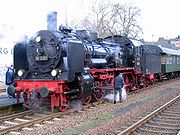
Bochum Dahlhausen Railway Museum
Encyclopedia




Railway museum
A railway museum is a museum that explores the history of all aspects of rail related transportation, including: locomotives , railway cars, trams, and railway signalling equipment.See List of railway museums...
situated south of the city of Bochum
Bochum
Bochum is a city in North Rhine-Westphalia, western Germany. It is located in the Ruhr area and is surrounded by the cities of Essen, Gelsenkirchen, Herne, Castrop-Rauxel, Dortmund, Witten and Hattingen.-History:...
in the state of North Rhine-Westphalia
North Rhine-Westphalia
North Rhine-Westphalia is the most populous state of Germany, with four of the country's ten largest cities. The state was formed in 1946 as a merger of the northern Rhineland and Westphalia, both formerly part of Prussia. Its capital is Düsseldorf. The state is currently run by a coalition of the...
, Germany
Germany
Germany , officially the Federal Republic of Germany , is a federal parliamentary republic in Europe. The country consists of 16 states while the capital and largest city is Berlin. Germany covers an area of 357,021 km2 and has a largely temperate seasonal climate...
. It was founded by DGEG
DGEG
The German Railway History Company or DGEG is a society concerned with the history of the railways...
, the German Railway History Company in 1977 and is based in a locomotive depot that was built between 1916 and 1918 and ceased operation in 1969. Then DGEG took over the whole area of 46,000 square meters and built up the biggest railway museum
Museum
A museum is an institution that cares for a collection of artifacts and other objects of scientific, artistic, cultural, or historical importance and makes them available for public viewing through exhibits that may be permanent or temporary. Most large museums are located in major cities...
in Germany. In the middle of the museum, there is an engine shed with fourteen tracks. A preserved turntable, coaling, watering, and sanding facilities are still in operation. This museum is integrated into The Industrial Heritage Trail
The Industrial Heritage Trail
The Industrial Heritage Trail links tourist attractions related to the industrial heritage in the Ruhr area in Germany. It is a part of the European Route of Industrial Heritage.-The route:...
(Route der Industriekultur) a route of monuments from the history of the industry.
Exhibits
The origins of the vehicle collection go back to 1967. A variety of steam locomotives and other technically interesting railway vehicles from different epochs are displayed. There are over 200 exhibits in total. The stars of the exhibition are the heavy locomotives.Examples include:
- DRG Class 01DRG Class 01The Deutsche Reichsbahn-Gesellschaft's BR 01 steam locomotives were the first standardised steam express passenger locomotives built by the unified German railway system. They were of 4-6-2 "Pacific" wheel arrangement in the Whyte notation, or 2′C1′ h2 in the UIC classification. The idea of...
- DRG Class 44DRG Class 44The Class 44 was a ten-coupled, heavy goods train steam locomotive built for the Deutsche Reichsbahn as a standard steam engine class . Its sub-class was G 56.20 and it had triple cylinders...
- DRG Class 50
- DRG Class 80DRG Class 80The Class 80 tank engines were German standard locomotives with the Deutsche Reichsbahn. They were intended to replace the aging, rickety state railway line engines performing shunting duties in their dotage at large stations.- History :...
(in grey photo livery) - Bavarian S 3/6Bavarian S 3/6The Class S 3/6 steam locomotives of the Royal Bavarian State Railways were express train locomotives with a 4-6-2 Pacific or 2'C1' wheel arrangement....
(cut-away model; currently exhibit at Deutsches Museum, Munich) - Prussian P 8Prussian P 8The Prussian Class P 8 steam locomotive of the Prussian state railways was built from 1906 onwards by the Berliner Maschinenbau and the Linke-Hofmann factory in Breslau by Robert Garbe...
- Prussian T 9.1 (being overhauled)
- Prussian T 20Prussian T 20The German DRG Class 95 was a ten-coupled tank locomotive with a 2-10-2 wheel arrangement, which was procured by the Deutsche Reichsbahn in 1922 for hauling heavy goods trains on steep main lines...
- Württemberg HzWürttemberg HzThe Württemberg Hz were 0-10-0 rack and adhesion steam locomotives, that were initially developed by the Royal Württemberg State Railways , but were delivered to the Deutsche Reichsbahn-Gesellschaft in the mid-1920s.- Design :The locomotives had a Winterthur cogwheel drive with one lower and one...
- DB Class 66DB Class 66The DB Class 66 was a class of two Deutsche Bundesbahn locomotives designed for fast goods train and passenger train services on the main and branch lines of Deutsche Bundesbahn , the national railway of the former West Germany.-History:The Class 66 were one of several newly designed locomotive...
- DRG Class E 32
- DRB Class E 94
- Wehrmacht locomotive WR 360 C 14
- DB Class 212
- DB Class V 65DB Class V 65The DB Class V 65 locomotives were German, eight-wheeled, rod-coupled diesel locomotives operated by Deutsche Bundesbahn intended for light railway services and medium-heavy shunting duties...
- Wismar RailbusWismar railbusThe 'Hanover version' of the Wismar railbus was developed in the early 1930s as a light railbus for economical passenger services on branch lines in Germany.- History :...
- DB Class ETA 150DB Class ETA 150The accumulator cars of Class ETA 150 were German railbuses used extensively by the Deutsche Bundesbahn over 40 years. The driving cars were very comfortable to travel in because they were quiet , rode well on the rails due to the weight of the batteries and were pollution-free...
Amongst the exhibits there is even a collection of signals with a functioning Prussian signal box, that stood in Cologne-Mülheim until 1982. The exhibits are looked after by 130 mainly voluntary employees, who are also involved in the museum railway services where they wear historical uniforms.
At present the museum is busy refurbishing locomotive number 66 002 with the help of donations.
Museum vehicles and installations are often used for film and television productions. For example, a large part of the railway scenes in the film "Das Wunder von Bern" took place in Dahlhausen.
A highlight in the history of the railway museum was the large vehicle show put on in 1985 as part of the 150th anniversary of the German railways.
Museum Railway
In summer regular museum train services are operated by the Ruhr Valley Railway (Ruhrtalbahn) along the banks of the river Ruhr to HagenHagen
Hagen is the 39th-largest city in Germany, located in the federal state of North Rhine-Westphalia. It is located on the eastern edge of the Ruhr area, 15 km south of Dortmund, where the rivers Lenne, Volme and Ennepe meet the river Ruhr...
using a variety of locomotives, including a steam engine. A Prussian P 8
Prussian P 8
The Prussian Class P 8 steam locomotive of the Prussian state railways was built from 1906 onwards by the Berliner Maschinenbau and the Linke-Hofmann factory in Breslau by Robert Garbe...
(38 2267) owned by the museum is usually used for the steam services. In addition, from 2009 there will be regular trips to the Zollverein coal mine (Zeche Zollverein) via Mülheim
Mülheim
Mülheim an der Ruhr, also called "City on the River", is a city in North Rhine-Westphalia in Germany. It is located in the Ruhr Area between Duisburg, Essen, Oberhausen and Ratingen...
and Essen
Essen
- Origin of the name :In German-speaking countries, the name of the city Essen often causes confusion as to its origins, because it is commonly known as the German infinitive of the verb for the act of eating, and/or the German noun for food. Although scholars still dispute the interpretation of...
.
Part of the museum train to Hagen includes a restored passenger coach by MAN from 1921 belonging to the Essen Model Railway Club (Modell-Eisenbahn-Club Essen & Umgebung e.V.) founded in 1949.
Literature
- Vogelsang, Harald. Die Fahrzeuge und Anlagen des Eisenbahnmuseums Bochum-Dahlhausen, ISBN 3-921700-99-X
- Vogelsang, Harald. Das BW Bochum-Dahlhausen und die Eisenbahn im mittleren Ruhrtal. Eisenbahnkurier Verlag, ISBN 3-88255-430-4
External links
- Eisenbahnmuseum Bochum-Dahlhausen homepage
- Die Ruhrtalbahn
- German Railway History Company (Deutsche Gesellschaft für Eisenbahngeschichte or DGEG)
- Route Industriekultur (engl.)
- There is an English-language discussion forum at Railways of Germany

